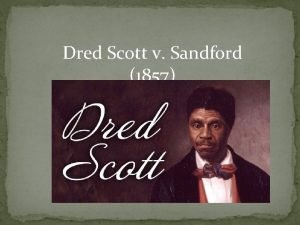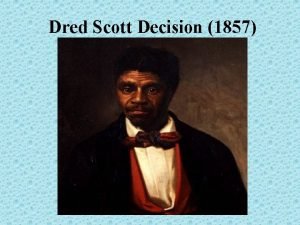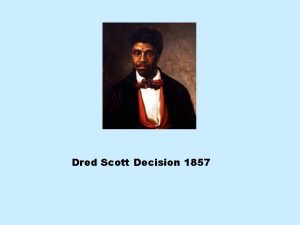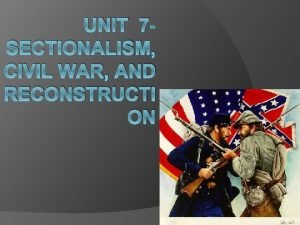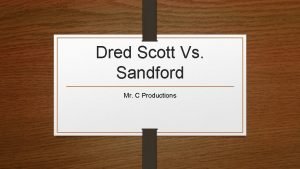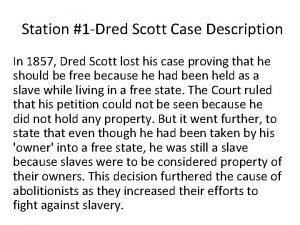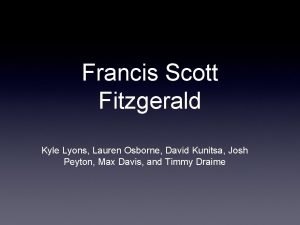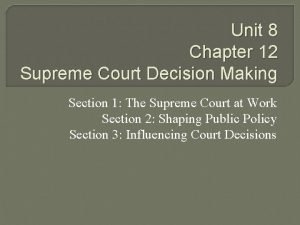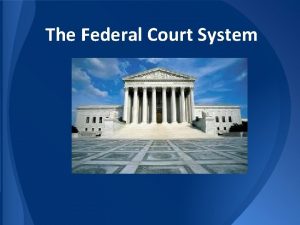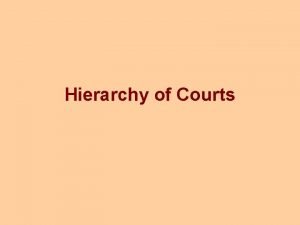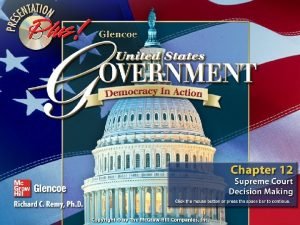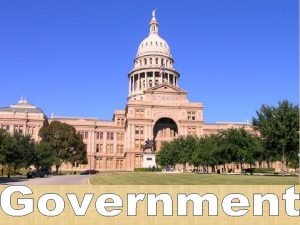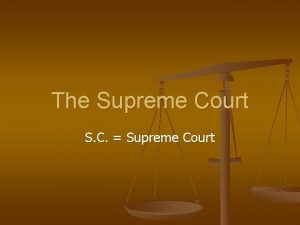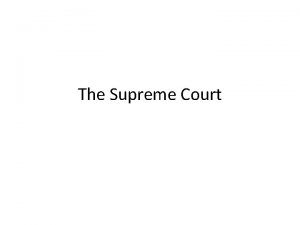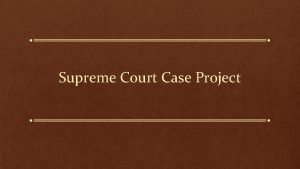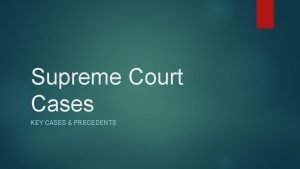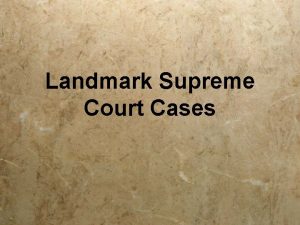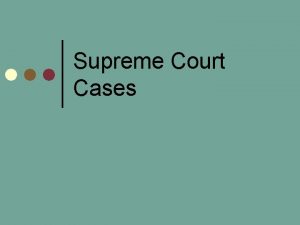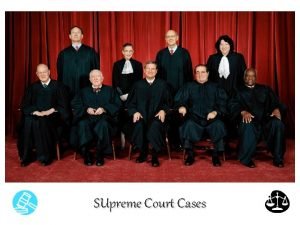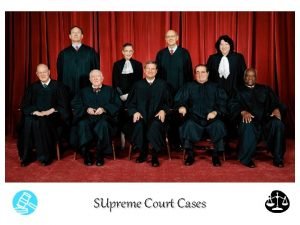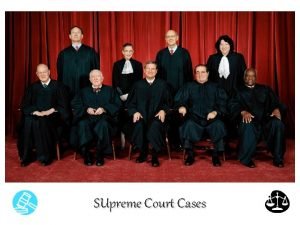DRED SCOTT AND THE SUPREME COURT 358 359



















- Slides: 19


• DRED SCOTT AND THE SUPREME COURT: (358 -359) – Dred Scott, a slave owned by John Emerson, accompanied Emerson when Emerson visited army posts in the Midwest – after Emerson’s death Dred Scott sued for freedom on the claim he had resided in Illinois and the Free Territory of Wisconsin so he should be free – This case reached the Supreme Court of the United States in 1856.

• DRED SCOTT AND THE SUPREME COURT: (358 -359) – Chief Justice of the Supreme Court, Roger B. Taney, was a southerner and he wrote the majority opinion of the Supreme Court which stated that Scott was not a citizen and therefore could not bring suit in U. S. Courts – Taney said that the nations founders view African Americans as “beings of an inferior order” having “no rights which the white man was bound to respect. ” – He argued that no African American, slave or free, could ever enjoy the rights of a U. S. citizen

• DRED SCOTT AND THE SUPREME COURT: (358 -359) – Although Dred Scott and his family were eventually freed by their owners, the Dred Scott decision outraged abolitionists and other opponents of the expansion of slavery

• LINCOLN and DOUGLASS: (359 -360) – The debate over the Dred Scott decision echoed across the land. Many young politicians gained a reputation by taking a stand on these issues – A political race in Illinois drew national attention as Republican Abraham Lincoln ran for a seat in the U. S. Senate – The conflict over slavery and the Kansas -Nebraska Act brought Lincoln back into politics – at one time he did serve in the House of Representatives – Lincoln would give speeches in Illinois denouncing that slavery was a “sacred right. ”

• LINCOLN and DOUGLASS: (359 -360) – In 1858, Lincoln would run against Stephen Douglass for the U. S. Senate seat in Congress – Stephen Douglas was known as a great speaker so he was given the name of “the little giant. ” – Stephen Douglas strongly supported the idea of popular sovereignty – allowing the territories to decide the slavery issue themselves – Douglas was a big supporter of POPULAR SOVEREIGNTY

• LINCOLN and DOUGLASS: (359 -360) – The Lincoln-Douglas debates: • Abraham Lincoln ran against Douglas in the 1858 senatorial race in Illinois • Lincoln challenged Douglas to a series of seven debates • Douglas excepted the challenge but acknowledged that Lincoln was “the best stump speaker in the West. ” • Many people turned out to hear the two men debate

• LINCOLN and DOUGLASS: (359 -360) – The Lincoln-Douglas debates: • During the debates Lincoln attacked the Dred Scott Decision, which seemed to grant broad constitutional protection to slavery • Like the Republican Party, Lincoln viewed slavery as “a moral, social, and political wrong. ” • Although Lincoln was willing to tolerate slavery in the South, he firmly opposed its expansion into the territories

• LINCOLN and DOUGLASS: (359360) – The Lincoln-Douglas debates: • In a heated debate at Freeport, Illinois, Lincoln challenged Douglas to explain how popular sovereignty was still workable • Douglas responded that the people of a territory could still keep slavery out simply by refusing to pass the local laws necessary to make a slave system work – this became known as the FREEPORT DOCTRINE. • Douglas wins the election for the U. S. Senate seat


• JOHN BROWN’S RAID: (361) – THE ATTACK ON HARPERS FERRY (361) • With money obtained from New England abolitionists, John Brown armed a band of some 20 men, including five African Americans • On October 16, 1859, John Brown’s small force seized the federal arsenal at Harpers Ferry, Virginia. • Brown planned to give the arsenal’s guns to slaves living nearby and to establish an independent regime in the southern Appalachian Mountains. • He hoped that runaway slaves and free African Americans would join him in his attempts to liberate slaves from their owners

JOHN BROWN

• JOHN BROWN’S RAID: (361) – THE ATTACK ON HARPERS FERRY (361) • John Brown was convicted of “murder, criminal conspiracy, and treason against the Commonwealth of Virginia” and was hanged on December 2, 1859. • Six of Brown’s followers were also executed

• JOHN BROWN’S RAID: (361) – Reactions to Brown: • Well-known abolitionists viewed Brown as a great moral figure. • In contrast, many southern whites, alarmed by the threat of slave revolts, viewed Brown as a bloodthirsty fanatic who deserved punishment. • Many southern secessionists, however, were pleased by the hysteria. They believed that the incident at Harpers Ferry would lead yeoman farmers and poor whites of the South to support the planter’s cause. • “There is – there can be no peace!”

• THE ELECTION OF 1860: (362) – A deeply divided Nation approached the presidential election of 1860 – Southern moderates formed the Constitutional Union Party and nominated John Bell – Democrat – Stephen Douglas – Southern Democrats pick John Beckinridge – Republican Party nominated Abraham Lincoln – Lincoln Wins ELECTION OF 1860

• SECESSSION! (362 -363) – Despite Abraham Lincoln’s moderate stance of slavery, many southerners viewed his victory as a victory for abolition – The South Carolina legislature called a convention and unanimously voted to leave the Union – Alabama, Georgia, Louisiana, Mississippi, and Texas soon passed similar acts of secession – Confederate States of America – drafted a new constitution that resembled the U. S. Constitution, with two key exceptions: the Confederate constitution guaranteed the right to own slaves and it stressed that each state was “sovereign and independent. ” – Jefferson Davis is provisional president of the Confederacy

• SECESSSION! (362 -363) – The southern secessionists justified their position with the doctrine of states’ rights – They asserted that since individual states had come together to form the Union, a state had the right to withdraw from the Union. – THE NORTHERNERS countered that by ratifying the Constitution, the states had agreed to recognize it as the supreme law of the land

• SECESSSION! (362 -363) – The Southerners feared that restricting slavery in the territories would ensure that the slave states remained a minority. Then, eventually, the northern majority in Congress would not only prohibit slavery in the territories but abolish it in the South

 Is there a basketball court above the supreme court
Is there a basketball court above the supreme court Dred scott case define
Dred scott case define Dred scott decision what happened
Dred scott decision what happened Facts about dred scott
Facts about dred scott The dred scott decision timeline
The dred scott decision timeline Civil war and reconstruction achieve 3000 answer key
Civil war and reconstruction achieve 3000 answer key Dred scott vs. sandford 1857
Dred scott vs. sandford 1857 The dred scott decision
The dred scott decision Who made this
Who made this Wikipedia dred scott
Wikipedia dred scott What do these headlines say about how the supreme court
What do these headlines say about how the supreme court Vocabulary activity 12 supreme court decision making
Vocabulary activity 12 supreme court decision making Supreme court justice system
Supreme court justice system The supreme court change
The supreme court change Hierarchy of criminal courts in india
Hierarchy of criminal courts in india The u.s. supreme court works chiefly as a(n)
The u.s. supreme court works chiefly as a(n) Supreme court does
Supreme court does Supreme court does
Supreme court does Have supreme court
Have supreme court Victorian court hierarchy
Victorian court hierarchy

